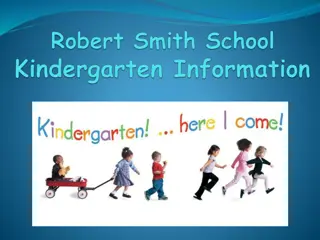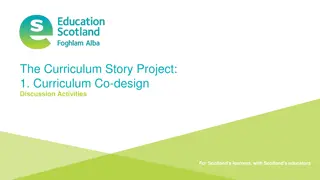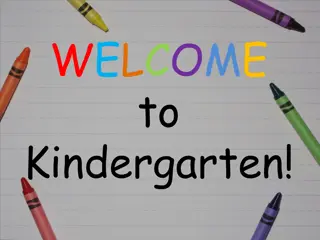Kindergarten Curriculum Reflection and Planning
Explore the Kindergarten curriculum through reflection and planning with a focus on children's interests, observation skills, and co-creation of learning experiences. Assessments guide the progression of individual readiness and developmental levels, emphasizing play-based learning and emergent interests.
Download Presentation

Please find below an Image/Link to download the presentation.
The content on the website is provided AS IS for your information and personal use only. It may not be sold, licensed, or shared on other websites without obtaining consent from the author.If you encounter any issues during the download, it is possible that the publisher has removed the file from their server.
You are allowed to download the files provided on this website for personal or commercial use, subject to the condition that they are used lawfully. All files are the property of their respective owners.
The content on the website is provided AS IS for your information and personal use only. It may not be sold, licensed, or shared on other websites without obtaining consent from the author.
E N D
Presentation Transcript
Kindergarten October 20, 2011
Year Plans, Invitations, & Provocations Refining Our Assessment
Our ability to view what the curriculum really is Our advanced skills in observing children Our ability to analyze children s thinking and development to see new levels of complexity Our ability to practice new skills and try new ideas Our experience that leads us to trusting children and oneself to co-creating the curriculum Our understanding of making learning visible Our ability to reflect and plan for instruction from our assessment
Share each others Year Plans What is similar? What is different? What are the necessities of a year plan?
Preamble: In Kindergarten, children explore, wonder, and investigate (through play) natural or constructed environments. Children can co-construct the curriculum with teachers based on the students emergent interests. Teachers structure, scaffold, make adaptations, develop essential questions, construct conversations, prepare invitations and opportunities for play and inquiry to further student s learning through the renewed and emergent curriculum. Assessment is ongoing in the Kindergarten program and children will progress in all curriculum outcomes along the learning continuum based on their individual readiness and developmental levels. Outcomes are revisited throughout the year. through play) in their
Pacing Guide with Flexibility (explained in preamble) All Outcomes Presented Key Learning Experiences: Invitations/Provocations Big Ideas Essential Questions
Listening closely to the children and devising a means for provoking further thought and action. An invitation might be an intriguing set of materials that tie into the children s interest, something new in a learning centre, a display that invites hands-on exploration, or perhaps library books on a topic.
Kindergarten Year Plan Who am I? Acorns How doI make my message clearer? Play Conversations Aquarium What is a 3D object? PEK.4PEK.5PEK.6PEK.7, NK.1NK.2 NK.3NK.5 How do I stay safe? Leaves PEK.3 NK.4 PEK.2 NK.5 Howare we unique? PEK.1 PK.1 Mathematics Physical Education APK.1 SSK.1 Dirt SandSoil How can I show the same quantity in two different ways? DMK.1 SSK.2 Why are patterns important? Health USCK.3, SSK.3 USCK.2 LTK.1 What is a promise? Howdo I represent my thoughts and feelings? Principles of Early Learning USCK.1 FEK.1 Science Environment Invitations ARK.2 MOK.1 ARK.1 NSK.1, Books CC:SL INK.1 Musical Instruments ELA Whatmakes an object easier or harder to move? Social Studies CC:O INK.2 Why do things change? CC:M, DRK.1 CR:RI DRK.2 Flowers CR:TF DRK.3 Arts Education Buttons CR:I PAK.1 What isa good listener? CHK.1 PAK.2 Why do I like music? CRK.1, RWK.1 CPK.4, RWK.2 CPK.3 CPK.1 CPK.2 Essential Questions Activities How do I sort? CulturalDresses Magnets Play doh
Putting It All Together
What are High Quality Assessment Tools? How does Assessment drive Instruction? How do we measure Personal and Social Development in subject areas?
Analyze the assessment evidence that you have brought with you today. Pull up the rubric that you would assess this evidence. As a group, discuss where your student would lie on the continuum of learning on the rubric. Each person in your group will share their assessment evidence.
How consistent were your group members in deciding the level on the continuum? Does the assessment event fit the criteria as defined within the rubric? Does this experience match the criteria? What would exceeding expectations look like in this assessment? How would it be different from meeting expectations? How could the assessment event be made more reflective of the outcome and its rubric criteria? How could we structure this assessment for better management?
Video Clip: A present for mom CCK.4 Writing a message. Focus on Message & Language Cues & Conventions
Oct. 20 Oct. 20 Oct. 20 Oct. 20 Oct. 20 Oct. 20 Oct. 20 Oct. 20 Oct. 20 Oct. 20 Oct. 20 Oct. 20
Boy Girl
What props, materials, conversations, questions, activities will be presented tomorrow for these children? Learning Plan Environment/Invitations Environment/Invitations Conversations/Essential Conversations/Essential Questions Play/Activity Play/Activity Questions
How does your instruction change tomorrow based on the information you have gathered today? How does your assessment drive your instruction? Even if it s summative how does this information inform you to your next learning outcome? Now what? What do you do? What invitations, props, assessment events, and conversations do you need to facilitate? How does your learning plan change? How do you look at today so that it becomes meaningful tomorrow?
What does the criteria of the PSD look like in various subjects? When and how would you measure these criteria in subjects? What feedback and questions do you have about the PSD Rubric? Submit the template at the end of this activity.























